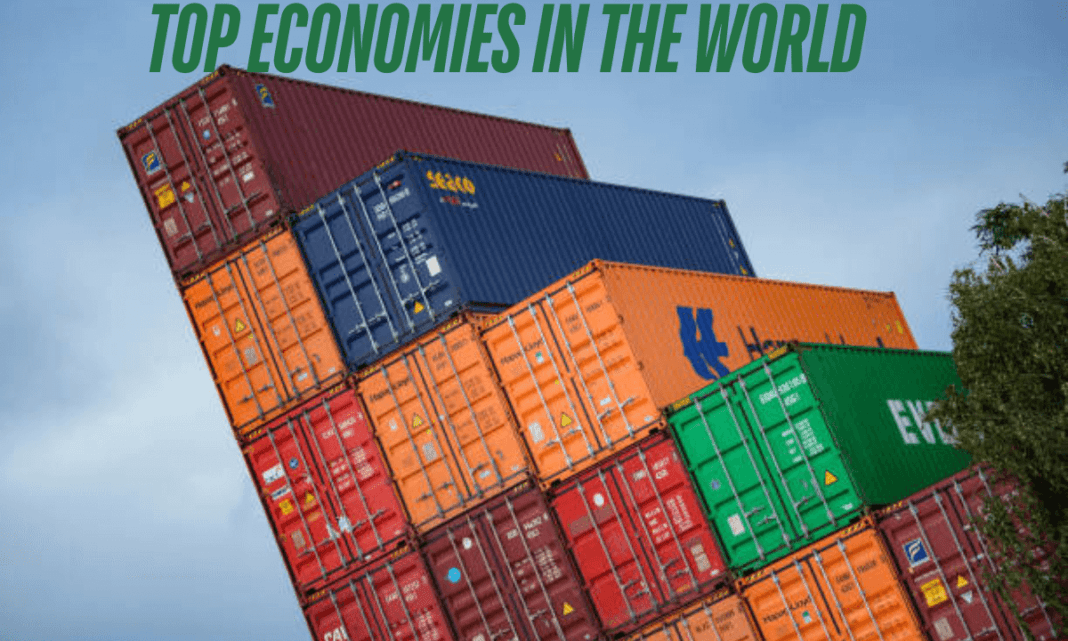The 25 Top Economies in the World

In 2024, according to their GDP data, the top economies in the world are the U.S., China, Germany, Japan, and India. A nation’s GDP is a crucial indicator of its economic size.
In 2022, the United States GDP was over 40% more than China’s, the World’s No. 2 economy. Even more stunning, the U.S. GDP was more than five times that of Germany and Japan, which are the following biggest economies.
How Did It Become The Top Economies in the World?
The gross domestic product is the total value of all goods and services produced within a country in a specific year. (GDP). Financial and statistical organizations rank countries according to their nominal GDP estimates, which are determined using market or official exchange rates.
Differences in the cost of living among nations are not factored into nominal GDP, and the findings can fluctuate substantially from year to year due to changes in the country’s currency exchange rates. While these changes seldom affect people’s living standards, they can affect a country’s yearly rating.
Purchasing power parity (PPP) is another standard metric for comparing national wealth since it accounts for variations in living costs between countries.
An additional indicator for comparing the national standard of living is nominal GDP per capita, used in conjunction with a matching GDP (PPP) per capita. Overall, there is less variation in PPP per capita numbers compared to nominal GDP per capita numbers.
The 25 Top Economies in the World
According to GDP, the World’s leading economies are the United States, China, Germany, Japan, and India. GDP calculates the financial value of all end products and services generated within a country’s borders in a specified period, usually a year. A country’s GDP is a standard metric for gauging its economic power and influence on the world stage.
Finding GDP
Using local prices and currencies converted into U.S. dollars using currency market exchange rates, nominal GDP in current U.S. dollars is the most basic and frequent approach to measure and compare GDP among countries.
This rank metric was utilized to rank the top 25; the metric comparing nominal GDP among nations is the Purchasing Power Parity (PPP).
Adjusted GDP in Current International Dollars. This method uses the purchasing power of a basket of goods rather than currency exchange rates to adjust currencies. This approach accounts for the fact that different countries have different cost of living rates.
Gross Domestic Product (GDP) Growth:
This measures a nation’s economic expansion rate by looking at its nominal GDP in local prices and currencies and calculating the percentage growth rate each year.
GDP per capita, expressed in current U.S. dollars, is the product of a country’s nominal GDP and population. Instead of looking at a country’s GDP, per capita breaks it down by population. A country’s level of living or income can be roughly estimated using this metric as well.
1. American nation
- U.S. GDP: $28.78T
- Current International Dollars PPP Adjusted GDP: $28.78 trillion
- Economic Growth: 2.7%
- In current U.S. dollars, the nominal GDP per capita is $85,370.
The nominal gross domestic product ranks the U.S. economy above all others. The financial, real estate, insurance, professional, commercial services, and healthcare industries make up the bulk of the economy’s service sector, which is the primary driver of GDP.
Because of its liberal economic policies, the United States welcomes FDI and other forms of flexible corporate investment. It produces the World’s principal reserve currency. It is the preeminent geopolitical force, allowing it to sustain a massive external national debt.
2. China


- In today’s money, the nominal gross domestic product is $18.53 trillion.
- Current International Dollars PPP Adjusted GDP: $35.29 trillion
- Economic Growth: 4.6%
- Current U.S. Dollar Nominal GDP Per Capita: $13,140
When measured in current currency, China’s GDP is second, but it ranks first when adjusted for purchasing power parity (PPP). Some analysts have speculated that China’s economy would eventually surpass America’s, the biggest in the World, thanks to its historically strong expansion over the past two decades.
3. The German Republic
- Current U.S. Dollar Nominal Gross Domestic Product: $4.59 trillion
- 5.69 trillion USD (PPP Adjusted) in Current International Dollars
- Gross Domestic Product: 0.2 per cent
- In current U.S. dollars, the nominal GDP per capita is $54,290.
The German economy ranks third in the globe. Additionally, Germany has the biggest economy in Europe.
German workers are among the best in the World, and the country’s exports of automobiles, machines, chemicals, and other industrial items reflect this. However, demographic challenges are slowing Germany’s economic progress.
Because of its high net immigration rates and low birth rate, the country struggles to replace its ageing workforce and fund its social safety programs.
The Tapswap Airdrop: All the Info You Need
4. Japan
- Current U.S. Dollar Nominal Gross Domestic Product: $4.11 trillion
- $6.72 trillion, adjusted for purchasing power parity, in today’s international currency
- Gross Domestic Product: 0.9%
- In current U.S. dollars, the nominal GDP per capita is $33,140.
When it comes to global economies, Japan ranks fourth. A manufacturing and export-oriented economy has grown in Japan thanks to the country’s high level of technical know-how and the close relationship between the government and the business sector.
The keiretsu system is the backbone of many large Japanese corporations.
5. India


- Current U.S. Dollar Nominal Gross Domestic Product: $3.94 trillion
- The GDP adjusted for PPP in current international dollars is $14.59 trillion.
- Economic Growth: 6.8%
- In current U.S. dollars, the nominal GDP per capita is $2,730.
- The Indian economy ranks fifth globally. India ranks last in GDP per capita due to its massive population.
Traditional village farming and handicrafts coexist with contemporary industries and mechanized agriculture in India’s thriving economy. The service sector accounts for a substantial portion of India’s GDP, and the country is well-known as an exporter of technological services and commercial outsourcing.
While India’s economy has grown because of liberalization during the 1990s, the country still faces obstacles to further expansion, such as rigid business regulations, pervasive corruption, and chronic poverty.
6. British
- Present Value of Gross Domestic Product in U.S. Dollars: $3.5 trillion
- 4.03 trillion U.S. dollars in current international dollars for PPP-adjusted GDP
- 5.0% increase in GDP
- In current U.S. dollars, the nominal GDP per capita is $51,070
The country. Financial, insurance, and commercial services comprise a disproportionate share of the service sector, which drives the economy.
The settlement of Brexit following the 2016 decision to leave the European Union (E.U.) has significantly affected the nation’s vast commercial connection with continental Europe.
The U.K. will stop collecting VAT on goods imported on January 31, 2020. remains a non-member of the European Union (E.U.), but trade talks between the two blocs are controversial.
Best Life Insurance Companies: Best Term, Whole, and No-Exam for May 2024
7. France
- Amounting to $3.13 trillion in current U.S. dollars, the nominal GDP
- 3.99 trillion USD (PPP Adjusted) in Current International Dollars
- Revenue Increase: 0.7%
- Annual Gross Domestic Product (GDP) in Current US Dollars: $47,360
The gross domestic product (GDP) of France ranks sixth globally. The tourism business is vital; annually, more people visit France than any other country.
Numerous private and semi-private companies in various sectors make up France’s mixed economy. However, the government is still very involved in essential areas, such as military and power generation.
8. South America.brazil
- In today’s money, the nominal gross domestic product is $2.33 trillion.
- $4.27 trillion, adjusted for purchasing power parity, in today’s international currency
- Economic Growth: 2.2%
- In current U.S. dollars, the nominal GDP per capita is $11,350.
With the largest economy in South America, Brazil ranks eighth globally. Brazil’s economy is diverse, from exploiting minerals and energy resources to heavy sectors like aircraft and automobile production. Since it has a sizable agricultural industry, it is also a leading exporter of soybeans and coffee.
9. Italy


- In today’s money, the nominal gross domestic product is $2.33 trillion
- 3.35 trillion USD (PPP Adjusted) in Current International Dollars
- Revenue Increase: 0.7%
- Income Level in Current U.S. Dollars Per Capita: $39,580
With a GDP of 9.0 per cent, Italy ranks ninth in the World. Furthermore, it ranks as the third-biggest economy in the Eurozone.
Italy’s industrialized north and relatively undeveloped south are two sides of the same coin regarding the country’s economy and degree of development.
Due to a substantial underground economy, an ineffective labour market, a poor banking sector, a high level of public debt, and a chronically high youth unemployment rate, Italy’s economy grows steadily.
Top 10 Furniture Websites in the United States
10. North America/Canada
- Current U.S. Dollar Nominal Gross Domestic Product: $2.24 trillion
- The adjusted PPP GDP is $2.47 trillion in today’s international currency.
- 2.2% increase in GDP
- Fiscal Year 2019 Nominal GDP Per Capita: $54,870
The Canadian economy ranks tenth in the World. With the third-largest oil reserves, Canada boasts a highly developed energy production sector. Most of Canada’s impressive industrial and service industries are located in the country’s major cities close to the United States border.
11. Russian Federation
- Gross domestic product (GDP) in current U.S. dollars: $2.06 trillion
- $5.47 trillion, adjusted for purchasing power parity, in today’s international currency
- 2.2% increase in GDP
- Current U.S. Dollar Nominal GDP Per Capita: $14,390
Although Russia’s economy has become increasingly market-based in the three decades following the Soviet Union’s dissolution, many businesses are still owned or heavily influenced by the government.
The Russian economy is very vulnerable to fluctuations in global commodity prices because of the country’s position as a major exporter of petroleum, natural gas, and other minerals and metals.
Fidelity Brokerage Accounts: Top-Rated Online Brokerage Account and Trading Platform in 2024
12. Mexico
- In today’s money, the nominal gross domestic product is $2.02 trillion.
- Current International Dollars PPP Adjusted GDP: $3.43 trillion
- Economic Growth: 2.4%
- In current U.S. dollars, the nominal GDP per capita is $15,250.
- Among the World’s economies, Mexico ranks twelfth.
Mexico has transformed into a manufacturing powerhouse throughout the last 30 years. The supply chains of numerous large American manufacturers now include Mexican subsidiaries or affiliates. Exports from Mexico range from petroleum and agricultural goods to consumer electronics, automobiles, and auto parts.
13. The Nation of Australia


- Current U.S. Nominal Gross Domestic Product: $1.79 trillion
- Current International Dollars PPP Adjusted GDP: $1.79 trillion
- Economic Growth: 1.5
- In current U.S. dollars, the nominal GDP per capita is $66,590.
Australia has a vast web of free trade agreements with trading partners throughout the Asia-Pacific region and a relatively open home economy.
The country’s energy (coal and natural gas), metal (gold and iron ore), and agricultural products (beef and sheep products) export industries benefit from this. Still, Australia is now more susceptible to fluctuations in global commodity demand and prices.
14. Korean Peninsula
- In today’s money, the nominal gross domestic product is $1.76 trillion.
- Current International Dollars PPP Adjusted GDP: $3.06 trillion
- 2.3% increase in GDP
- Current U.S. Dollar Nominal GDP Per Capita: $34,160
- In a global perspective, South Korea’s GDP ranks fourteenth.
The economy of South Korea is a shining example of a prosperous nation that emerged as an industrial powerhouse in the twentieth century. Thanks to its chaebols, or substantial corporate conglomerates, and its export-led growth strategy,
South Korea has established a web of free trade agreements spanning 58 nations, with a combined GDP of over 75% of the global total. It generates much revenue from selling automobiles, electronics, and telecommunications equipment.
16. The Indonesian islands
- With today’s exchange rate, nominal GDP is $1.48 trillion.
- In current international dollars, the GDP adjusted for price changes is $4.72 trillion.
- Increase in GDP: 5%
- Current U.S. Dollar Nominal GDP Per Capita: $5,270
The export of commodities is the backbone of Indonesia’s economy, which ranks first in Southeast Asia. Petroleum and coal are two of the most important exports, along with agricultural goods like rubber and palm oil, also used for industrial applications.
Even though Indonesia’s budget deficit in 2023 was aimed at 2.81% to 2.95% of GDP, the country’s growing economy is nonetheless beset by regional inequality, inadequate infrastructure, and endemic governmental corruption.
17. Netherlands
- The nominal GDP of the Netherlands is $1.14 billion in current U.S. dollars.
- 11.33% of GDP in current international dollars after adjusting for price and product differences
- GDP growth of 0.6%
- Current U.S. Dollars Nominal GDP Per Capita: $63,750
- The economy of the Netherlands is the seventeenth biggest in the World.
Aside from its role as a global transport hub, the Netherlands is also home to several industrial manufacturing facilities and facilities for processing and extracting petroleum.
Its agricultural sector is second to none and has a highly developed agriculture sector. The Dutch Ministry of Finance backs the country’s sizable financial services industry, which participates in asset pooling.
18. Turkey


- The nominal GDP of Turkey is currently $1.11 trillion in U.S. dollars.
- Present Value Adjusted Gross Domestic Product in Current International Dollars: $3.83 trillion
- Economic Growth: 3.1%
- $6, Real Gross Domestic Product Per Capita in 2018 USD
The world’s and service sectors contribute significantly to Turkey’s open economy. The electronics, petrochemical, and automobile manufacturing industries are among the most critical sectors.
There has been considerable volatility in Turkey’s financial and currency markets and a lack of clarity on the country’s economic future due to political unrest and participation in regional conflicts.
MetaMask: A Guide to Using Binance Smart Chain BEP20 Addresses
19. Saudi Arabia
- Amounting to $1.11 trillion in current U.S. dollars, the nominal GDP
- 17 Current international dollars for PPP-adjusted GDP: $2.35 trillion
- GDP Growth: 2.6%\
- Current U.S. Dollars Nominal GDP Per Capita: $33,040
Oil is king in Saudi Arabia and the most significant oil exporter in the World. Aramco, the Saudi government-owned, controls much of the Saudi economy.
However, in response to growing interest in alternative energy sources caused by worldwide environmental concerns, the Saudis seek to diversify their economy by attracting private investment in healthcare and other service sectors.
20. Switzerland
- Gross domestic product (GDP) in monetary terms: $938.46 billion
- 17 In Current International Dollars, PPP Adjusted GDP: $816.46 billion
- Economic Growth: 1.3%
- in current U.S. dollars, the nominal GDP per capita is $105,670.
A highly trained workforce supports Switzerland’s booming service industry, which includes banking and insurance and the country’s high-tech manufacturing sector.
21. Poland,
- Current U.S. Dollar Nominal Gross Domestic Product: $844.62 billion
- The GDP adjusted for purchasing power parity in current international dollars is $1.8 trillion.
- Economic Growth: 3.1%
- 6-$23,010, the nominal GDP per capita in 2010 USD
The Polish World relies heavily on heavy industry, encompassing shipbuilding, coal mining, machinery manufacturing, iron and steel production, and more.
Thanks to its business-friendly environment and strong macroeconomic policies, Poland was the only European Union member state to escape recession following the 2008 financial crisis. Future growth in Poland will face obstacles from an aging population and ineffective legal and regulatory systems.
22. Taiwan


- The nominal gross domestic product in current U.S. dollars is $802.96 billion.
- $1.79 trillion, adjusted for purchasing power parity, in current international dollars
- Economic Growth: 3.1%
- Current U.S. Dollars Nominal GDP Per Capita: $34,430
It is a center for the production of computer chips and is renowned for its superior technology. Chemicals, textiles, petroleum refining, communications, I.T. products, and others are major players. The most famous agricultural products exported from Taiwan are chicken, pork, vegetables, and rice.
23. Belgium
- $555.19B in current U.S. dollars, the nominal GDP
- Dollars (in current international dollars): $803.17 billion, adjusted for price index
- 5.2 Increase in GDP: 1.2%
- $55,540 in current U.S. dollars for nominal GDP per capita.
Belgium ranks 23rd in the World. The diverse economy of Belgium, which serves as a crossroads for trade and transportation, includes sectors such as services, manufacturing, and high technology.
24. Sweden,
- Gross Domestic Product (GDP) in Current American Dollars: $623bn
- The GDP adjusted for purchasing power parity in current international dollars is $736.4 billion. Growth: 0.2 per cent
- Current U.S. Dollars Nominal GDP Per Capita: $58,530
Sweden has the World’s twenty-fourth-largest economy. A generous social welfare state in Sweden’s competitive economy contributes to the country’s high standard of living. Machines, cars, and telecoms are some of the most exported goods from Sweden’s manufacturing sector.
25. Argentina
- Current U.S. Dollar Nominal Gross Domestic Product: $604.26 billion
- PPP 17 Revalued Gross Domestic Product in Today’s Foreign Currency: $1.24 trillion
- Inflation: -2.8%
- Current U.S. Dollar Nominal GDP Per Capita: $12,810
After agriculture and services, Argentina’s industrial sector ranks highest in GDP contributors. The food processing, automotive, consumer durable, textile, chemical, printing, metallurgical, and steel sectors are all part of it.
Brazil, the United States, Chile, and China are its top export partners, and their relationship is only getting stronger. Petroleum, automobiles, natural gas, and soybeans are its principal imports.
FAQs
Which nation’s GDP is the lowest?
Tuvalu, a South Pacific nation comprising nine islands, had the World’s smallest GDP at the end of the First World.
Can You Tell Me Which Global Economy Is Developing the Most Rapidly?
Rumour has it that Guyana’s flourishing oil sector is a significant contributor to the country’s high GDP development, making it the fastest-growing economy in the World. The country’s gross domestic product will be 33.9% in 2024.
Which nation owes the most money?
At $34.6 trillion as of May 28, 2024, the United States’ national debt is the biggest of any country.
The Final Verdict
Gross domestic product (GDP) counts all final goods and services produced inside a country to indicate economic health and size. A country’s GDP growth rate is a reliable indicator of financial health and policymakers’ ability to steer the economy in a positive direction.
Factors influencing the economic and, by extension, GDP performance of the nations on this list include demographics, politics, trade agreements, and population size.
As a reader, I am incredibly grateful to you. If you want to read my next posts, which combine ideas from psychology, social issues, education, business, biographies, women, leadership, tourism, climate change, and many more, you should follow me. You may sign up for my email list if you want to receive notifications whenever I post a new article.




